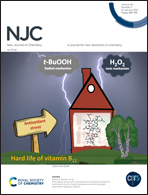Non-enzymatic electrochemical glucose sensing by Cu2O octahedrons: elucidating the protein adsorption signature†
Abstract
A facile solution based chemical route has been developed for the synthesis of cuprous oxide (Cu2O) octahedrons employing polyvinylpyrrolidone (PVP ∼ 10k) at a relatively low temperature (50 °C) in aqueous medium and their response towards electrochemical non-enzymatic glucose sensing has been precisely investigated. The amperometric analysis reveals two calibration ranges (0.1 μM–1 mM and 1–7 mM) for the modified electrodes, with an excellent glucose specific selectivity over other interfering materials like sucrose, fructose, ascorbic acid (AA) and dopamine (DA). Careful analysis of the amperometric outcomes unveils a low limit of detection (LOD) of 0.96 μM (S/N = 3) along with exceptionally good stability and repeatability. Furthermore, the octahedral Cu2O modified electrodes exhibit a fast response time (∼1.5 s) with acceptable sensitivity and are found to be exceedingly reliable for the real time analysis of human serum samples (relative error <3.2%) compared to commercial glucose biosensors. Detailed survey of the adsorption of four most common blood proteins onto the negatively charged surface of Cu2O octahedrons using steady state fluorescence, dynamic light scattering (DLS), zeta potential (ζ) and circular dichroism (CD) in aqueous dispersions delineates the electrostatic interaction driven low protein adsorption that strongly indicates their further potential applicability in medical devices for targeted monitoring of glucose.



 Please wait while we load your content...
Please wait while we load your content...